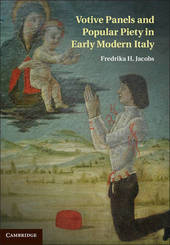
|
Votive Panels and Popular Piety in Early Modern Italy
Hardback
Main Details
Description
In the late fifteenth century, votive panel paintings, or tavolette votive, began to accumulate around reliquary shrines and miracle-working images throughout Italy. Although often dismissed as popular art of little aesthetic consequence, more than 1,500 panels from the fifteenth and sixteenth centuries are extant, a testimony to their ubiquity and importance in religious practice. Humble in both their materiality and style, they represent donors in prayer and supplicants petitioning a saint at a dramatic moment of crisis. In this book, Fredrika H. Jacobs traces the origins and development of the use of votive panels in this period. She examines the form, context and functional value of votive panels, and considers how they created meaning for the person who dedicated them as well as how they accrued meaning in relationship to other images and objects within a sacred space activated by practices of cultic culture.
Author Biography
Fredrika H. Jacobs is Professor Emerita of Art History, Virginia Commonwealth University. She is the author of Defining the Renaissance 'Virtuosa': Women Artists and the Language of Art History and Criticism (Cambridge University Press, 1997) and The Living Image in Renaissance Art (Cambridge University Press, 2005). She has contributed numerous essays to a variety of books dealing with gender, aesthetics and popular culture in the Renaissance. Her work has appeared in numerous scholarly journals and anthologies, including Renaissance Quarterly, The Art Bulletin, and Word and Image.
Reviews'Jacobs writes beautifully ... through her nuanced investigation of early modern (and current) terminology, she has greatly expanded our understanding of the complex, dynamic relationships of word, image, and piety by means of these little known tavolette and their myriad contexts. The book is a notable contribution to scholarship on sanctity, miraculous images, and the attendant practices of votive donation.' Barbara Wisch, Renaissance Quarterly
|